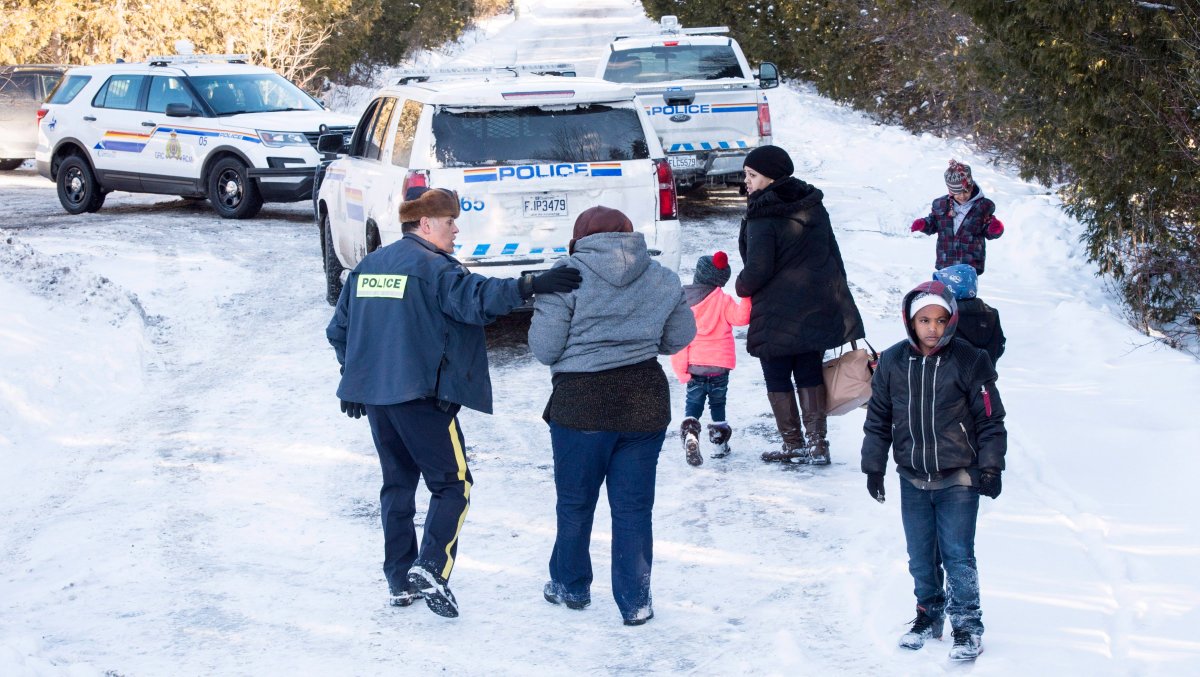The number of asylum seekers illegally crossing the border from the United States into Canada has indeed been on the rise this winter, government officials confirmed on Thursday morning at a briefing in Ottawa.

With those crossings, there have been questions and confusion from Canadians about how these asylum seekers are processed, where they end up and whether they effectively cheat the system by crossing away from a legal border checkpoint.
READ MORE: Spring weather not guaranteed to bring more U.S. asylum seekers, official says
Here’s a look at some of the most common questions, and misconceptions.
Are asylum seekers ‘queue jumping’ when they cross illegally?
No, and officials say this is a critical point.
The people crossing illegally at the border are doing so to avoid being sent back to the United States under the Safe Third Country Agreement, and in that sense they are taking advantage of a loophole.
Once they cross and are arrested, however, they are taken to see a government official to determine if they are eligible to make an asylum claim. Their files are not processed before, or prioritized over, those of people who make their claims after crossing legally at a border checkpoint, or who make a claim inside Canada at a government office.
WATCH: Trump’s travel ban was ‘a trigger point’ for some asylum seekers to Canada: Ralph Goodale

They are also not processed before, prioritized over, or “taking the place” of the files of refugee claimants who are going through the process of coming to Canada by initiating a claim from a refugee camp or another location overseas.
READ MORE: Canada braces for spring surge of asylum seekers
The two kinds of refugee claimants are, in fact, two different streams. Refugees who are processed abroad, like the Syrian refugees cleared by the United Nations and then by Canadian officials last year, normally arrive on Canadian soil as permanent residents and receive significant support from private sponsorship groups or the government on arrival (housing, language training, etc).
People who simply cross the border and make a claim have none of these privileges.
Do border-jumpers avoid security screening?
No. Before they are allowed to walk away from the border checkpoint and enter Canada, all asylum seekers who cross illegally (and are therefore arrested) undergo what officials describe as a “thorough risk assessment.”
- Roll Up To Win? Tim Hortons says $55K boat win email was ‘human error’
- Bird flu risk to humans an ‘enormous concern,’ WHO says. Here’s what to know
- Halifax homeless encampment hits double capacity, officials mull next step
- Ontario premier calls cost of gas ‘absolutely disgusting,’ raises price-gouging concerns
That includes fingerprinting, criminal record checks, gathering of biometric and biographical information, determination of their identity and status in the U.S. or other countries, checks to see if they’re facing a removal order in the U.S., and the examination of phones, computers, electronics and baggage by border officials.
Experts have also pointed out that anyone who poses a significant security threat to Canada probably wouldn’t choose to walk across the border illegally, opening themselves up to immediate arrest, searches and questioning by officials.
What help do asylum seekers get from government?
Asylum seekers who cross the border and make a claim do qualify for the Interim Federal Health Program (IFHP). But only once the government has determined they are eligible to make a refugee claim.
The IFHP provides “limited, temporary coverage of health-care benefits,” including hospital services, diagnostic tests, pre- and post-natal care and doctors’ visits. It also covers some supplemental services, like limited vision care and urgent dental care.
READ MORE: No, Canada doesn’t spend more on refugees than on pensioners
Children seeking asylum in Canada are eligible to attend school when they arrive. Adults can apply for permission to work or to attend school while they wait for their claim to be processed.
Claimants can apply to individual provinces and municipalities for things like social assistance or emergency housing, but they’re not eligible yet for federally funded settlement services, like language training and employment counselling.
If their claim fails, are they forced to leave?
This one is tricky, as there are a number of factors at play. First, once a claim is rejected, there are several avenues of appeal open to a refugee claimant, no matter how they first crossed into Canada.
They can potentially take their case to the Refugee Appeal Division, for example, or to a federal court.
Once all of those options have been exhausted, however, a removal order requires the asylum-seeker to leave Canada. If they don’t, they’re subject to arrest, detention and being escorted out of the country.
WATCH: Word of mouth drawing asylum seekers to Canada

But there’s an additional layer of complexity that applies to claimants from countries like Syria, the Central African Republic, South Sudan, Libya, Yemen, Burundi, Haiti and parts of Somalia.
These countries are subject to what’s called an administrative deferral of removals (ADR). The ADR temporarily halts the removal of failed claimants from these countries because of an ongoing humanitarian crisis.
Somalia is home to many of the asylum-seekers currently crossing into Manitoba, and until the ADR lifts, the immigration department confirmed that they may not be immediately deported — even if their refugee claims and subsequent appeals are rejected.
If someone’s asylum claim is rejected for reasons of “criminality, international or human rights violations, organized crime, or security,” however, they can be removed right away, despite an ADR.




Comments